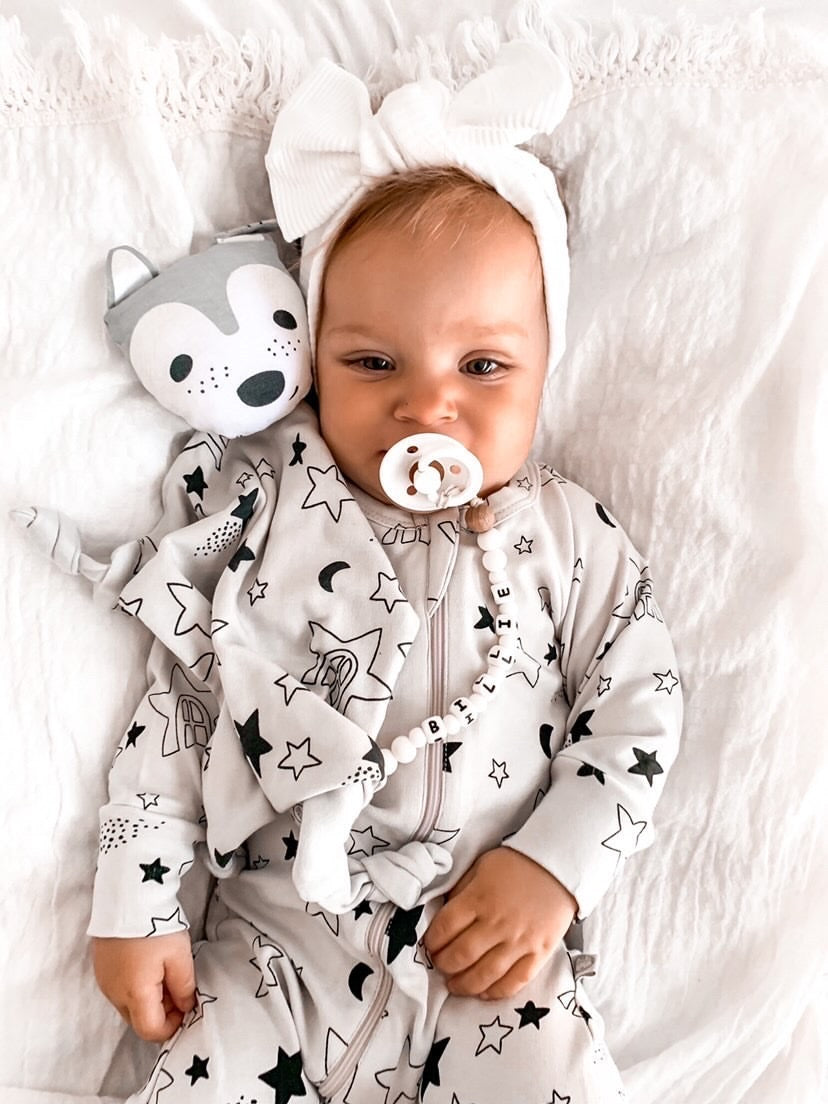What makes a Kippin the perfect baby comforter?

We’ve combined the essential aspects of a safe sleep comforter in the one Kippiny product that’s better for baby, and the planet!
Simple, smooth and safe
-
We chose smooth, organic cotton over a plush fabric. Plush fabrics may shed hairs that can be inhaled into baby’s lungs or ingested into their stomachs. Organic cotton is also naturally hypoallergenic, and great for baby's sensitive skin.
-
We use no buttons or embroidery, reducing any choking hazards when baby chews on the face (spoiler: baby will definitely chew on the face).
-
We avoided any unnecessary tags, loops, Velcro or snap button attachments. Often these things are included to help with the functionality of the comforter, for example, for holding a dummy. However, these are also points which could come loose when chewed, or irritating to baby’s sensitive skin. Instead, a dummy can be tied to a Kippin’s leg using simple, firm knot.
- Many parents ask us when it is safe to use a comforter unsupervised in the cot. Red Nose (formerly SIDS) say that from 7 months is the safest time to introduce a comforter.
Lightweight & Breathable
- Cotton is a natural fibre that will better regulate temperature. When your babe is hugging their comforter in the cot, there is a reduced risk of overheating. Traditional, plush comforters are often made from polyester (a plastic fibre), which can contribute to overheating and sweating.
- Cotton will also absorb your scent, so you can pop your Kippin down your top so that babe will smell you always!
- A Kippin’s blanket and stuffed head format means that the blanket portion will either lie flat or with a ‘wave’ format. It means that there is always airflow around the blankie, with less risk of it becoming a gas trapping object. The squishy head still allows the baby to enjoy the comfort of a soft toy, without the bulkiness of a big, plush comforter. It also helps them identify their Kippin in the dark and soothe themselves back to sleep.
The perfect size
- Sleep consultants suggest that a handkerchief (the kind your Dad might have used when you were little) sized comforter is ideal. It means that it is big enough for little hands to find in the dark, but not large enough to pose a suffocation risk in the same way a larger blanket would. A Kippin is just the right size and will be big enough for your child as they age.
- A Kippin’s legs and arms aren’t just great for chewing. When firmly knotted, these extend the size of your baby comforter so that it can be found easily in the cot or bed, without having to increase the size of the blanket portion itself (don’t forget that natural knots are great for teething).
High contrast prints
- Baby’s eyesight is pretty blurry in those early days. They can see large, high contrast prints and not much else. So when we saw that most comforters had small, embroidered eyes and facial elements, we thought we’d do things differently! A Kippin’s big, bold patterns will help stimulate baby’s eyesight. Don’t be surprised if you catch them having a stare!
Machine washable
- Your Kippin will get dirty, we guarantee it! And because they hang around with babies, expect a little spew and snot to get thrown in the mix! Our Kippins love to take a bath in cold water – you can chuck them in the washing machine on a gentle cycle. Always make sure to use a gentle detergent. We love the Eco Store range!
Characters to connect with
- Personifying their special friend is one of the ways in which your child will create a secure attachment. We created an entire story and world for our Kippiny characters that will bring magic to your bedtime routine and spark your child’s imagination!
Want to see more reasons why Kippins make the perfect comforter? Come and hang out with us on Instagram and hear from real parents who LOVE the Kippins!
Our range is safety tested to three international standards!
When should I introduce a Kippin to my baby?
The perfect time to introduce a Kippin in your baby’s cot or bed is 6-7 months of age. This is ‘the zone’ - before they experience separation anxiety, but after they are developed enough to appreciate the comforter (and with the motor skills to move it around).
Ready to meet the Kippin who will become baby's best friend? We have twelve Kippiny characters to choose from!

